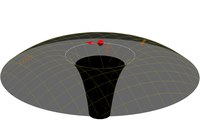
Photo from wikipedia
Synchrotron emission polarization is very sensitive to the magnetic field configuration. Recently, polarization of synchrotron emission with a mixed (SM) magnetic field in the gamma-ray burst (GRB) afterglow phase has… Click to show full abstract
Synchrotron emission polarization is very sensitive to the magnetic field configuration. Recently, polarization of synchrotron emission with a mixed (SM) magnetic field in the gamma-ray burst (GRB) afterglow phase has been developed. Here, we apply these SM models to the GRB prompt phase and compare their polarization properties with that of synchrotron emission in purely ordered (SO) magnetic field. We find that the polarization properties in an SM model are very similar to these in a corresponding SO model (e.g., synchrotron emission in a mixed magnetic field with an aligned ordered part (SMA) and synchrotron emission with a purely ordered aligned magnetic field (SOA)), only with a lower polarization degree (PD). We also discuss the statistical properties of the models. We find PDs of the simulated bursts are concentrated around 25% for both SOA and synchrotron emission in a purely ordered toroidal magnetic field (SOT), while they can range from 0% to 25% for SMA and synchrotron emission in a mixed magnetic field with a toroidal ordered part (SMT), depending on ξB value, i.e., the ratio of magnetic reduction of the ordered magnetic field over that of random magnetic field. From statistics, if PDs of majority GRBs are non-zero, then it favors SO and SM models. Further, if there are some bright GRBs with prominently lower PDs than that of the majority GRBs, it favors SOT (SMT) models; if all the bright GRBs have comparable PDs with the majority ones, it favors SOA (SMA) models. Finally, we apply our results to POLAR’s data and find that ∼ 10% time-integrated PDs of the observed bursts favor SMA and SMT models, and the ξB parameter of these bursts is constrained to be around 1.135.
Journal Title: Research in Astronomy and Astrophysics
Year Published: 2020
Link to full text (if available)
Share on Social Media: Sign Up to like & get
recommendations!